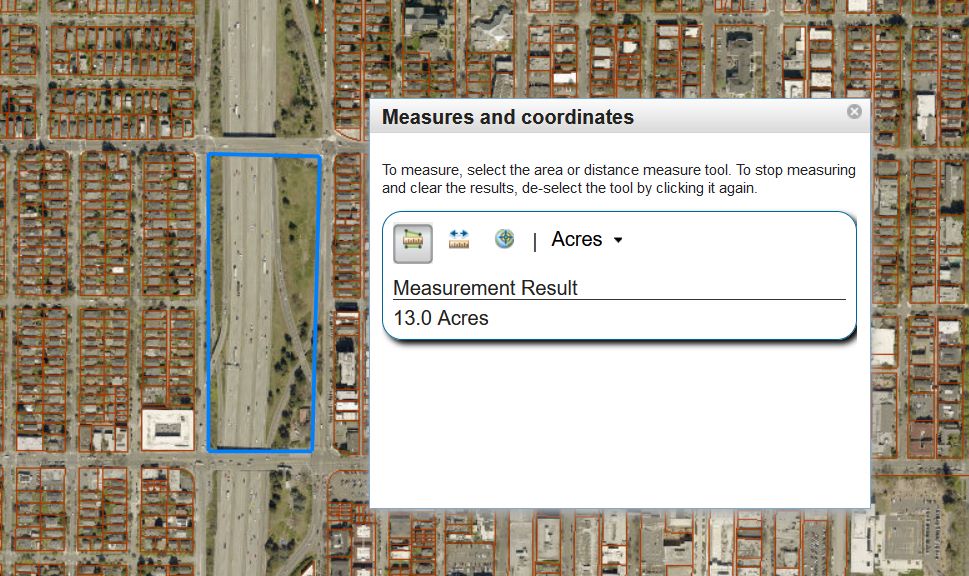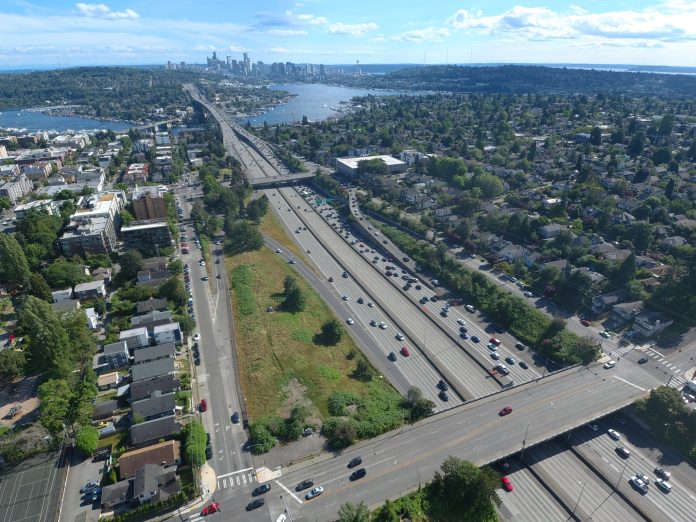
On Thursday, November 9th, the U District Partnership, the Lid I-5 campaign, and the UW Scan Design Master Studio will be hosting a community vision workshop focused on lidding Interstate 5 between NE 45th and NE 50th Streets. People of all walks of life are encouraged to come out and share their ideas for how they would like to see the area transformed by a freeway lid. With about 13 acres of land that could be created by the project, the opportunities are significant.
It is undeniable that Seattle’s U District is a neighborhood on the rise. Gleaming towers, both newly completed and still in the works, are creating a new skyline for the area. A walk along NE 45th Street west from the university campus reveals a landscape dense with housing, businesses, and public transportation options, including a Link light rail station that has become a focal point for activity in the neighborhood since its opening in 2021.
But if you travel a quarter-mile away from the light rail station, the bustling neighborhood abruptly comes to a halt as it hits the chasm of Interstate 5. Flanked by on and off ramps, the wide freeway canyon creates a barrier between the U District and Wallingford to the west. While it is technically possible to navigate the crossing on foot or bike, narrow sidewalks and heavy vehicle traffic make it unsafe and intimidating for many people.
Advocates have pushed for making infrastructure changes to create safer conditions, but their calls were met with plans for new railings on the freeway bridge rather than more space for walking and biking – a disappointment for many people who live in and travel through the area.
However, if you stand on the NE 45th Street bridge and look out over I-5, it doesn’t take much of a leap of imagination to envision how much the surrounding area would benefit if the freeway’s traffic, noise, and pollution were hidden by a lid. Space now dedicated solely to vehicles could be used for affordable housing, businesses, public parks, and safe walking and biking trails — finally creating a safe connection between Wallingford and the U District.
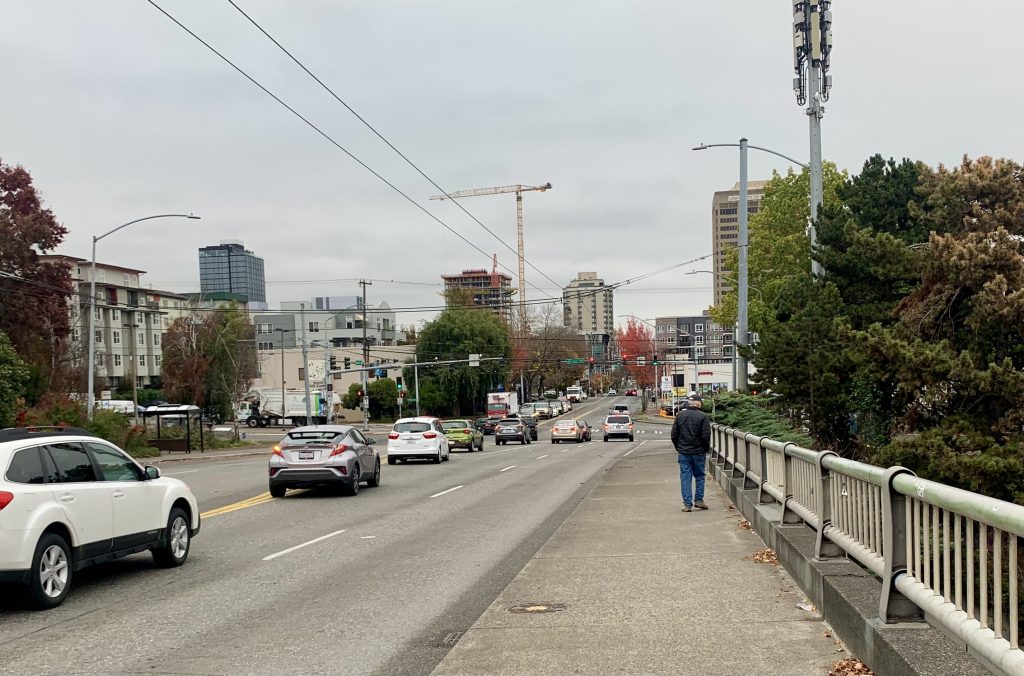
Because of these kinds of benefits, the campaign to build freeway lids over Interstate 5 in Seattle has been picking up momentum and support – and not just in the U District. Lid I-5 hosted design workshops for the U District lid back in 2017, which The Urbanist covered. This September the Seattle City Council passed a resolution in favor of building freeway lids, and with the support of the Lid I-5 campaign, the Seattle Office of Community Development and Planning (OPCD) applied for a federal Reconnecting Communities grant that would advance the work accomplished in the 2020 technical feasibility study, which focused on a lid study area in Downtown Seattle.
While the Downtown Seattle freeway lid has garnered the majority of attention so far, the unique benefits of a freeway lid over NE 45th and NE 50th Streets have not gone unnoticed. The concept has attracted the attention of the U District Partnership, an organization that works to keep the neighborhood clean, safe, and vibrant through an array of services like economic development, homeless outreach, and community events like the iconic annual U District Street Fair.
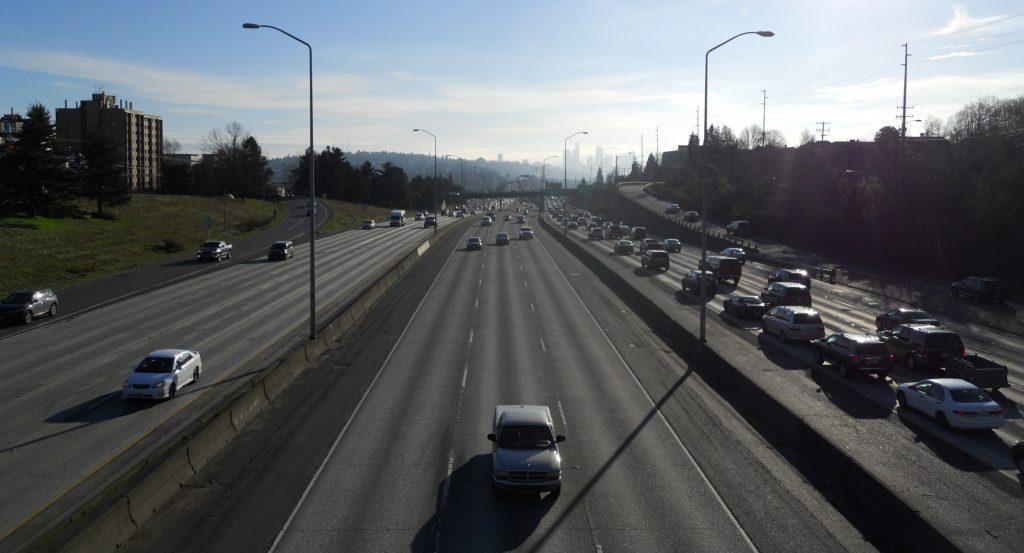
The U District Partnership has taken a leading role in a new campaign dubbed Lid I-5 North. Katy Ricchiuto, Urban Vitality Manager, thinks the advocating for lidding I-5 in the U District is a natural fit for the organization.
“At the U District Partnership we regularly engage with the community to try to source new priorities. And through that we’ve heard a lot of things pop out, including a need for affordable housing and open space. People are saying for a neighborhood that’s growing this fast we have to be able to play catch up on some of our resources,” Ricchiuto said in an interview with The Urbanist.
According to Ricchiuto, the U District Partnership recognized that what the neighborhood would need to achieve some of its goals was land – and that the Interstate 5 corridor could present a unique opportunity.
“It might sound funny to say it, but with I-5 we do have a lot of government land in our neighborhood that’s not being used productively,” Ricchiuto said.
The presence of publicly owned land adjacent to the freeway between NE 45th and NE 50th Streets – an estimated seven acres in total – could potentially make it easier, and more affordable to engage in construction on a future lid because future buildings could be anchored to it.
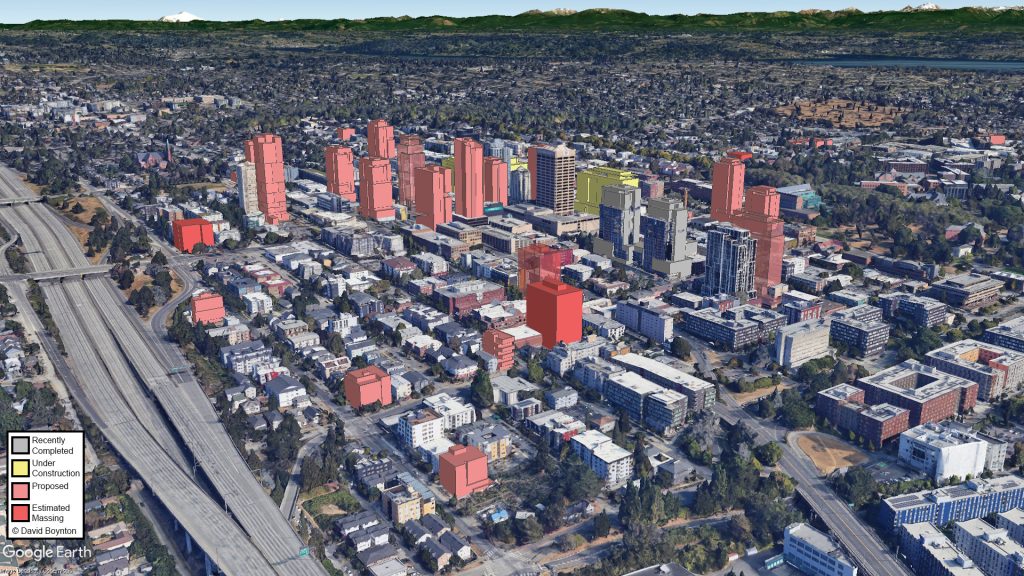
While Ricchiuto points out that a technical feasibility study has not yet completed, as it has for the lid study area in Downtown Seattle, she believes the presence of the adjacent land at very least makes it worthwhile to warrant further studying of a freeway lid in the area.
Fortunately there is already a large-scale study on the way that could help to advance a U District lid project. The Washington State Department of Transportation is currently engaged in an I-5 ramp study, and data collected as part of that effort will increase an understanding of how ramps could be reconfigured in the area – valuable information to have on hand when planning for a future lid and the development that might accompany it.
Since its inception, the Lid I-5 campaign (full disclosure: I serve on the Lid I-5 steering committee) has sought to inspire community groups in other Seattle neighborhoods to take on the cause of mitigating the damage caused by the freeway, and with Lid I-5 North these efforts are beginning to bear fruit.
With its history in the neighborhood and the variety of services it provides for U District residents, businesses, and visitors, the U District Partnership is stepping up as a formidable ally in the campaign to envision a different, and better future, for Seattle neighborhoods negatively impacted by I-5.
The University of Washington Department of Urban Design and Planning, which has also contributed to the lid effort through work completed by students, is another partner who could help make the vision of a freeway lid become reality.
So with this kind of support behind it, the community vision workshop on November 9th for the U District freeway lid promises to be just the beginning of much community engagement and advocacy work to come.
Want to get involved with the Lid I-5 North campaign? You can sign up for the Lid I-5 North newsletter here. The campaign is also seeking steering committee members. To learn more, check out the Lid I-5 North campaign online.
Natalie Bicknell Argerious (she/her) is a reporter and podcast host at The Urbanist. She previously served as managing editor. A passionate urban explorer since childhood, she loves learning how to make cities more inclusive, vibrant, and environmentally resilient. You can often find her wandering around Seattle's Central District and Capitol Hill with her dogs and cat. Email her at natalie [at] theurbanist [dot] org.


